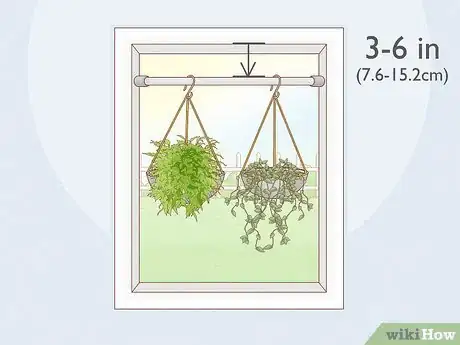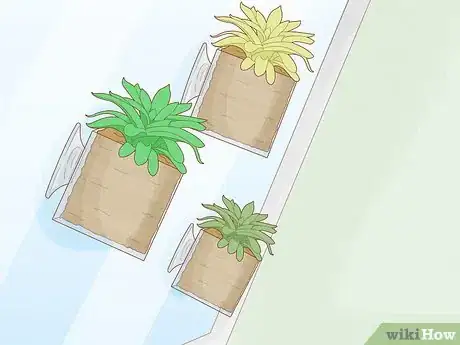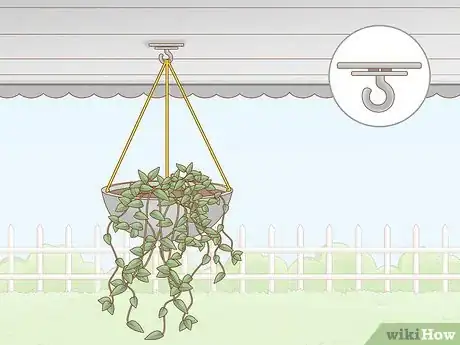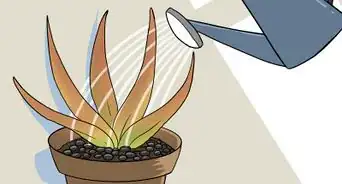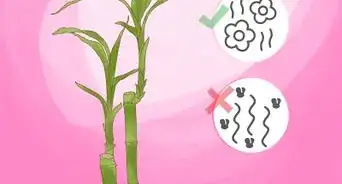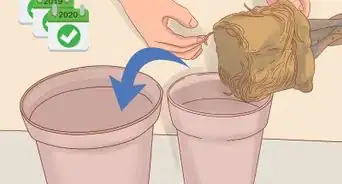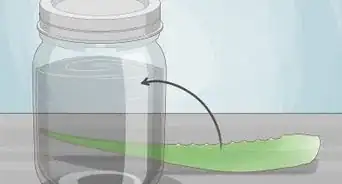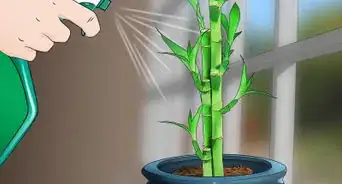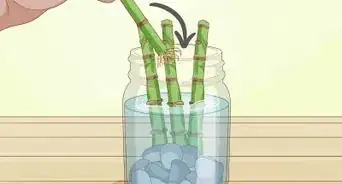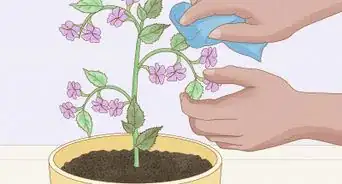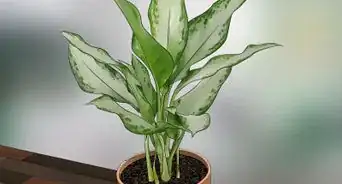This article was co-authored by Garrison Hullinger and by wikiHow staff writer, Eric McClure. Garrison Hullinger is an Interior Designer and the President of Garrison Hullinger Interior Design (GHID). With more than 15 years of experience, he specializes in client-centered design that balances beauty and warmth with comfort and functionality. Garrison and GHID’s work has been featured in numerous publications such as The New York Times, The Wall Street Journal, and Interior Design Magazine. Garrison attended Oklahoma Christian University.
There are 8 references cited in this article, which can be found at the bottom of the page.
This article has been viewed 195,638 times.
While plants are a great addition to any living space, they can start to look a little boring after a while if you don’t display them in unique ways. One of the best ways to mix it up is to hang your plants from the ceiling by drilling a hook into the drywall. Unfortunately, this can motivate your landlord to deduct money from your security deposit. It’s also not an ideal option if you don’t have a drill or aren’t particularly good with power tools. Don’t worry if the drill isn’t an option for you, there are plenty of ways to hang plants without punching holes into your walls or ceiling.
Steps
Hanging Plants from Walls, Windows, and Doors
-
1Suspend plants from a tension rod in a window frame for a subtle look. Tension rods rely on pressure to hold themselves in place, and they are commonly used to hold shower curtains or clothes in a closet. Pick up a tension rod and extend the bar while holding it inside of a window frame. Pull out the 2 ends of the rod until the pad on both ends are pushing against the frame. Place it 3–6 inches (7.6–15.2 cm) from the top of the window and hang your plants on it.[1]
- This is a great way to hang plants because the tension rod can handle a fair bit of weight and it won’t stand out too much in your room—many people may assume it’s simply part of your blinds.
- If you have plants that are hanging from rope and don’t have hooks, slide the rope over the rod before extending it inside of the window frame.
-
2Attach C-clamps to fixtures or walls that stick out for a modern option. If you have an open floorplan, arches, or open doorways, wrap the jaws of a C-clamp around a thin portion of drywall, 3–6 inches (7.6–15.2 cm) from the ceiling. Tighten the clamp by turning the handle clockwise until the pads on each jaw are firmly attached to your wall. Then, hang your plant on the clamp or from a portion of the bar that’s sticking out at end.[2]
- This is a really cool option if your home has a kind of industrial vibe.
- You can also do with exposed rafters or strong fixtures that are built-into your wall.
- Don’t tighten the clamp all the way. Stop once you feel a light amount of pressure from the tightening handle. If you continue to turn the handle and tighten the clamp, you may punch a hole in the wall.
Advertisement -
3Attach a trellis to command hooks and hang your plants on the bars. A trellis is basically a metal or wood grid used to display plants. Purchase 2 high-strength command hooks. You can buy a trellis at your local gardening store. Hang the top bars of the trellis on the command hooks and get some pots with built-in hooks for trellis-hanging. Loop the hooks over the bars of your trellis to attach them to the structure.[3]
- This is a really cool, contemporary option, but it’s a little more work than the other solutions. However, the end result is quite stunning!
- You can simply lean the trellis against a wall if you prefer. This is the best way to do it if you don’t want to put command hooks on your wall.
-
4Use over-the-door hooks to hang plants from unused doors. If there’s a door in your home that you don’t use very often, put over-the-door hooks over the top of the door and hang plants from them. These hooks are usually used for towels, but they’re strong enough to hold medium-sized plants in most cases. If you do this, be sure to get over-the-door hooks where the actual hooking portion sticks out at least 4–6 inches (10–15 cm) to give your pots room to hang.[4]
-
5Get lightweight pots with suction cups to hang plants on windows. There are several types of lightweight pots that come with built-in suction cups. Transfer any plant that loves well-drained soil and lots of light into the suction pots. Then, stick the suction cups against a window where you want to display your plants to hang them higher up in your home.[5]
- This is a really unique option since people don’t typically put plants directly against a window. It’s a great choice if you want to do something a little different or if you have really large windows.
- There are magnetic versions of these pots that allow you to hang plants on air ducts, fixtures, or your refrigerator if you prefer.
Suspending Plants from the Ceiling
-
1Use adhesive hooks to hang them from the ceiling without drilling. There are adhesive command hooks with adjustable hooks that are perfect for ceiling hanging. Purchase these hooks from an office supply or big box store. Peel the adhesive backing off and stick the back directly against the ceiling. Then, slide the hook or twine on your pot over the loop of the adjustable hook to hang it up.[6]
- You can also do this with standard command hooks if you want to hang them from a portion of trim or wall that doesn’t have any drywall underneath it.
Tip: This is the best option if you want to hang the plant directly from the ceiling. However, be sure to check the weight limitation for your command hooks before buying them. Typically, command hooks can hold 5–10 pounds (2.3–4.5 kg), so you have to get stronger hooks for heavier plants.
-
2Use a magnetic hook and wall magnet to hang your plant in the air. Get a high-strength magnetic hook, which is basically a magnetic plate with a hook attached to it. Attach the hook to an air duct, metal fixture, or air vent on your ceiling. Loop the hanging plant over the hook to hang it from your ceiling.[7]
- If you get a really strong magnetic hook, you may be able to attach them to drywall since there are nails in the studs.
- There are magnetic pots available on the market, but most of them have magnets on the side of the pot to hang them on your fridge or wall. These are a great option if you want to put plants on the wall, though!
-
3Opt for a suction cup hanger pot to hang lightweight plants without holes. There are a few suction cup pots that you can use to hang your plant from a skylight or tall window. Unfortunately, you can only use a suction cup hanger to safely hang a plant from glass, but it’s a great option that won’t put any holes in the wall. Keep in mind, suction cups are not a great solution for plants that are heavier than 5 pounds (2.3 kg), since they can pull the suction cup off of the glass over time.[8]
- If you have a large skylight, hanging 3-4 plants from the glass is a great way to create a modern look in your home.
Things You’ll Need
Attaching Plants to the Ceiling
- Adhesive hook
- Magnetic hook
- Suction cup hanger
Hanging Plants on the Wall
- Tension rod
- C-clamp
- Trellis
- Command hook
- Suction cup pot
Using Other Fixtures to Hang Plants
- Coat rack
- Suction cup pot
References
- ↑ https://cleverbloom.com/clever-ways-to-hang-your-plants/
- ↑ http://www.skywaymom.com/hook-hacks/
- ↑ https://www.contemporist.com/indoor-garden-idea-hang-your-plants-from-the-ceiling-walls/
- ↑ https://youtu.be/4a0cqphhK9uQ?t=35
- ↑ https://www.contemporist.com/indoor-garden-idea-hang-your-plants-from-the-ceiling-walls/
- ↑ https://youtu.be/4T0TxT6aBFA?t=315
- ↑ https://youtu.be/oc2NExVmm_Q?t=153
- ↑ https://nymag.com/strategist/article/best-hanging-plants-and-planters.html
- ↑ https://youtu.be/6_Cz_y8GDQ8?t=42
